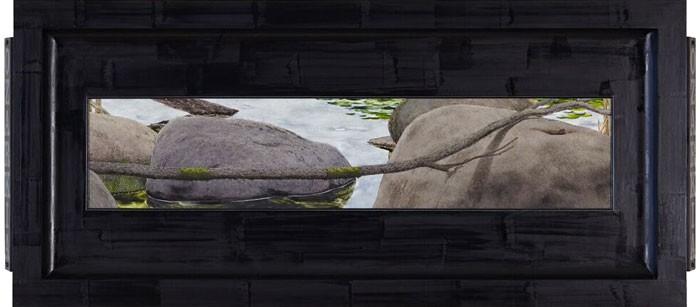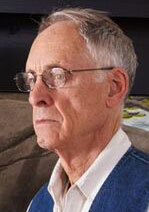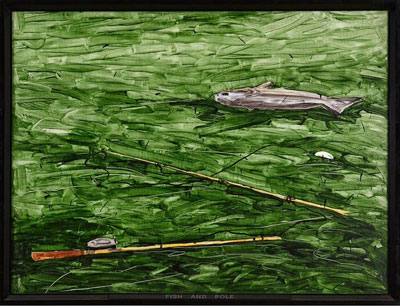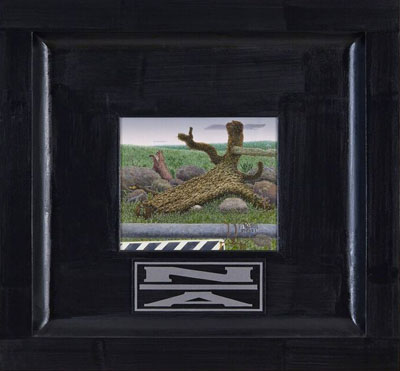Neil Jenney, Ozarkia, 2014. 27.875 x 61 x 3.25 in.
Viewed from a distance, a painting with representational components seems to possess the clarity of a photograph. As a viewer walks closer, however, manifestations of the human hand begin to appear: A rough stone. A truncated branch. An unnatural hue. An elevation of materials. At once the viewer values the change; but what is its essence?
Ozarkia is a recent oil painting by Neil Jenney, an artist whose work has been displayed at the Museum of Modern Art, The Metropolitan Museum of Art, the Whitney Museum of American Art, and the Corcoran Gallery of Art. The painting presents a scene of rocks, water lilies and tree branches one might encounter anywhere in the Arkansas wilds. A viewer recently asked the artist, “Could not this subject be presented just as well, or better, by a photograph?”
“A photograph wouldn’t be my statement,” Jenney responded. “It would be basically a scientific recording of reflected light. That has all the validity in the world, of course, but not as a human expression. It’s just a recording of what is. Photographers have very limited opportunities for adjustment. You just click what's there. You can’t shift a stone. Whereas if you have a pencil and paper, you can shift a stone with your fingertips.”
Jenney’s position suggests that an artist champions a pictorial statement linked to the human, one that is personal in approach and idiosyncratic in manifestation. Rather than a view of nature through an open window, Ozarkia offers a distinctive interpretation of the image of origination, achieved through the skilled utilization of a palette’s constructive materials. It suggests that for a creative artist the first formal questions must be “Which creative substance should be used? What characteristics of the employed materials will allow the best creative expression?” That Ozarkia is made with oils is a matter not of chance but of experience, a lifetime of work with formative substances and their potentials. Jenney has already expressed reserves about photography’s captured light, a substance which seems to lack what the artist refers to as sculptural presence, a characteristic deemed requisite to productive engagement. Over the course of his career Jenney has abandoned other constructive materials when they failed to meet his changing needs.
2
Born in 1945, Jenney discovered an early interest in art while growing up in Westfield, Massachusetts at a time when the high profile artists included Mark Tobey, Seymour Lipton, and Milton Resnick. When the abstract art of the day captured the young boy’s attention he managed to ferret out some examples despite the lack of nearby galleries. “Abstract art would make an appearance in Time magazine every month or two,” he recalls. “And we used to go through the long play jazz albums at Grant’s and Newberry’s, looking at the cover art. That’s where I discovered Motherwell.” As Jenney’s interest in art grew deeper he cultivated an appreciation for Franz Kline (especially his black period), Truman Egleston (who was doing a hard edged formalism) and Kenneth Nolan (of color field fame).
Neil Jenney
In 1966 Jenney made his move to a city that, he recalls, still retained a bit of innocent charm: “Frank Stella had a studio on Walker Street in those days, in the same building as a guy named Hollis Frampton whom we used to visit every now and then with Kasper Koenig, a friend of mine. We would walk up the stairs and the doors would be left open to Stella's studio and we'd look in. We could have gone in and taken stuff if we wanted to. They used to leave the studios open, if you can believe it. Doors unlocked.” As for his new direction, Jenney’s first decision was a shift from painting to sculpture, developing a style that reacted against the minimalistic order of the day. “I had very little money,” he says. “So I spent all my days looking in dumpsters to see what I could make ‘found sculpture’ out of.”
The result was a series of works Jenney labeled Linear Pieces. A lucky break occurred when these caught the attention of the well-known art dealer Richard Bellamy. “He was looking for what’s next,” recalls Jenney. “He looked at my work and said, ‘That’s next. That breaks the whole format of minimalism.’ Bellamy became my dealer and showed me along with Richard Serra and Bruce Nauman. We all started the same day in the same room on Madison Avenue.” Alas, a problem arose. Linear Pieces, while a critical success, failed to reap the financial rewards Jenney had anticipated. “Serra and Nauman were selling and I wasn't,” says Jenney. “I was kind of lamenting this to Bellamy, and he said, ‘Well, you know, Jenney, nobody's got floor space. But everybody's got wall space.’ I realized I had to start thinking about ideas on walls.” Indeed, Jenney’s fortunes changed when he began creating linear pieces for mounted display.
Neil Jenney, Fish and Pole, 1969. 58 x 75.5 x 4 in.
Jenney recalls a less than enthusiastic initial reception: “When Bellamy saw them he hated them. I insisted it was a good idea but no, he hated them, hated them. Couldn't even think about them. Eventually he did come around. At some point he said, ‘Listen Jenney, clean it up a little bit.’ I started to think that maybe I was a little sloppy, I had gone too far. I wanted to make him happy. So I said, ‘Okay, I'll clean them up a little bit. Basically what I ended up doing was good drawing and bad painting.” Jenney’s persistence finally paid off when Marcia Tucker, founder of the New Museum of Contemporary Art, wrote a high profile essay which pinned the ironic sobriquet of bad painting onto the artist’s efforts. Jenney became a hot commodity in the New York art scene.
Eventually Jenney felt he had taken bad painting as far as he could. It was time again for a change, and once again he felt the urge to buck the mood of the times. Reducing the element of abstraction in his work, he began to emphasize a kind of idiosyncratic “good drawing” and “good painting.” He dubbed the amalgamation sophisticated realism. “I think sophisticated realism means you start with a precise vision of what you want, and not just an ephemeral thing,” says Jenney. “The work is sophisticated in terms of its ability to achieve the vision that you’ve decided upon. This requires, first, the resolution of the imagery through the application of lines and the demarcation of boundaries. Then comes a sophisticated transformation from drawing to completed painting.” A successful work of sophisticated realism requires an experienced, talented, and deliberate hand: “The term ‘sophistication’ means having control over as much as you can. You always have accidental occurrences, which either benefit your work or which you have to repair. But I don’t like to depend on that as the moving factor.” And it requires sufficient time: “One of the elements of sophisticated realism that’s critical is the ability to go slow. You can’t rush to a conclusion and have it be really refined and sophisticated.”
Jenney believes the painting of the future will exhibit, like Ozarkia, sophisticated realism's characteristic touch of the human hand. “I think we're going to move toward realism, by which I mean not a photographic realism, not a computer generation, each of which is strictly 20th century. Handmade things have more validity today than they've ever had when everything is manufactured. Anything made by hand has a charm.”
3
From the standpoint of form, what is instructive about Jenney’s personal odyssey is the ability, or the necessity, of the artist to select the best constructive materials for the task at hand, then to skillfully manipulate those materials to allow the painting to rise above the level of the unadulterated photograph. At each step forward in his march toward sophisticated realism, Jenney discovered that a new direction called for a new material. In his abstract expressionist days he had employed tempera, a substance easily obtained and commonly used by other artists. Its drawbacks became apparent. “Tempera was basically like an opaque water color, in a way,” he recalls. “It was a choppy substance. It would crack if you added some thickness to it. And it didn’t have a binding agent to make it permanent.”
Jenney’s bad painting period offered the opportunity for change. “Acrylics were more permanent than tempera,” he recalls. “I also liked the fact that they were water soluble, and that they dried more quickly. You could move right along; you had to paint fast.” Painting fast, it turned out, was part and parcel of bad painting, which depended for its success upon deliberately sloppy drawing and the conscious application of color components with little attention to detail and nuance. No time was needed for a reworking that would only “improve” what must appear to be a raw, unfinished product. Acrylic, with its bold presence and rapidly drying nature, seemed the natural choice.
Neil Jenney, North America Divided, 2001,9. 26.25 x 28.125 x 3 in.
Oils also allowed Jenney to render color with greater nuance: “I realized that I could never achieve the precise chromatic unity I wanted with acrylics, which have basically symbolic colors with no atmospheric transition. Oils, in contrast, can carry heavier metals, heavier pigments, and still make them work. I think it’s because of oil’s binding viscosity.” Finally, oil possessed a beneficial textural potential. “I realized that with oil paint I could get a textural perspective. In the foreground, for example, I could apply more texture than I did in the rear. You couldn't really get that same effect with acrylics.” Examples of the artist's work in oils include Ozarkia and North America Divided (pictured right).
When the artist is successful in selecting and engineering the right constructive material, the subject of the work becomes more than a straightforward replication of the natural world. Fish and Pole offers an instructive example. At first viewing the discreet subjects serve an introductory purpose, inviting the reader to engage with the work by reflecting on the images not solely as symbolic objects but also as generators of relational tension. Once caught, however, experienced viewers engage on a deeper level, co-creating the work by reengaging the materials on palette. Through this dynamic, maintained Picasso, a picture transmogrifies to reflect the "state of mind" of its audience: "The picture lives only through the mind of the man who is looking at it” (8). It is this act of co-creation, the work’s meaning, which makes for a lasting work of art by allowing for a repeatable experience. No viewer would return to the images of Fish and Pole, or to the stone and branch of Ozarkia, if the works contained nothing but surface renditions of representational or symbolic images absent that meaningful engagement, that interpretative amalgamation, with constructive materials universally recognized as abstraction. Hence, Jenney says, abstraction is part of any successful work, even openly representational ones: “Abstraction is always an element in all art. In music, and in drawing and in painting and sculpture, it has to succeed abstractionally to succeed.”
At this point we can return to the question which opened this essay. What is the essence of that principle which creates in the viewer’s mind a value concurrent with the manifestations of the human hand? The answer might be referred to as a constructive dynamic, a productive exploitation of those characteristics of the materials of construction which for the artist becomes the driving gear in the creative machine.
Story by Walter Idlewild
Photographs courtesy West Broadway Gallery, New York City.
Posted March 6, 2016.
Work Cited
Ashton, Dore. Picasso on Art: A Selection of Views. Da Capo P. 1972.
Unattributed statements by Neil Jenney were recorded during interviews with Walter Idlewild in January and February of 2016.

